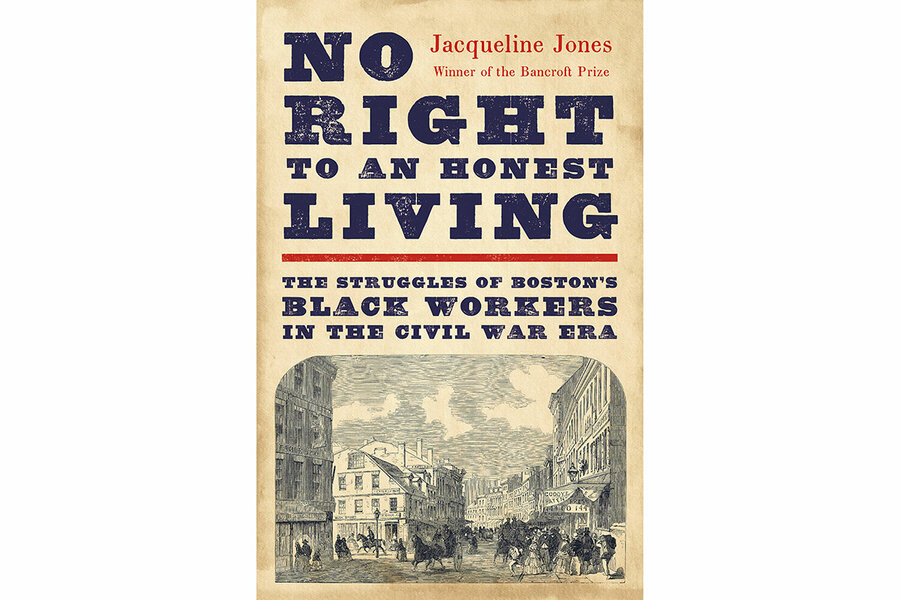How Black people were left behind in Civil War-era Boston
Loading...
A Black resident of post-bellum Boston once remarked that “we can go most anywhere with the white man, and spend our dollar, but we cannot go anywhere with the white man and earn it.” The lament captures a painful paradox for Black people in the Massachusetts capital during the Civil War period: The city was a hotbed of radical abolitionism, but most of its Black workers were consigned to unequal treatment and dead-end jobs.
Jacqueline Jones, a Bancroft Prize-winning historian, highlights the city’s entrenched economic disparities in the remarkable “No Right to an Honest Living: The Struggles of Boston’s Black Workers in the Civil War Era.” She divides the hefty book into three sections, chronicling the difficulties Black laborers encountered before, during, and after the war. At each juncture, she finds, “the casual cruelty endemic to the Boston job market contrasted with the soaring rhetoric of egalitarian-minded white men and women during the turbulent era of the Civil War.”
Jones brings this history to life with graceful storytelling and a generous use of primary sources. She returns to many of the same figures again and again, allowing readers to follow their experiences over time. Some were part of the Edloe 66, a group of men, women, and children who arrived in Boston in 1847 after being freed by their enslaver, Carter Edloe, upon his death. White abolitionists observed them with great interest, seeing them as something of an experiment in whether, in a post-emancipation world, formerly enslaved people would be able to support themselves by working, without having to depend on public or private aid.
Boston, however, with its discriminatory labor practices, made the conditions of the experiment decidedly unfavorable to the new arrivals. In the South, Jones observes, some enslaved men and women had become skilled as blacksmiths, coopers, or carpenters. Those who made their way to Boston, however, were rarely given the chance to make a living at their trades. Thomas Sims, for instance, was so valuable as a skilled bricklayer that even after his first escape from slavery his owner opted not to have him executed when he was forcibly returned to Georgia. But when Sims escaped a second time and settled in Boston, where white tradesmen monopolized the skilled jobs, he was unable to find work. He earned money by charging admission to his abolitionist speeches, hoping to earn enough to start his own business, but the effort failed.
Meanwhile, unskilled Black workers had little hope of learning a trade. Prominent Bostonian John S. Rock, the first Black attorney admitted to the bar of the Supreme Court, bemoaned the city’s lack of economic opportunity, asking, “Who is taking our boys into their stores at a low salary, and giving them a chance to rise? Who is admitting them into their work-shops, or into their counting-room?”
Throughout the book, Jones demonstrates that the issue of labor was front and center for Bostonians of the time. Massachusetts abolished slavery in 1783, and for years its egalitarian reputation attracted both free Blacks and fugitives from bondage. In 1855 the commonwealth banned segregated public schools, a further draw for Black families in particular.
But many of the city’s residents worried, for different reasons, about a Black population explosion. Boston’s white laborers refused to work side by side with Black laborers; the author writes that they “dreaded the possibility of an apocalyptic influx of former slaves” after the war. Employers exploited these anxieties, threatening to use newly arrived Black laborers as replacements if white workers demanded higher wages or went on strike. For their part, Black workers “were inclined to welcome long-lost kin among any southern newcomers,” Jones observes, “but they feared that even more rivals for Black jobs would depress already starvation-level wages.”
Jones’ exhaustive study covers much more of interest. She describes the particular challenges faced by Black women and Black veterans in Boston; she analyzes the growing political clout of the city’s Irish population, contrasting Irish mobility with Black exclusion.
“Most northern whites,” the author concludes, “regardless of party, were satisfied that, by destroying slavery, the nation had fulfilled its obligations to Black people.” In the end, Black Bostonians like the Edloe 66 looked out for each other, getting by as best they could. Jones gives credit to the city’s abolitionists for galvanizing many Americans with their eloquent antislavery arguments. But her work brings their “soaring rhetoric of freedom and equality” down to earth with the insistent reminder that “no one can live by constitutional rights alone.”








